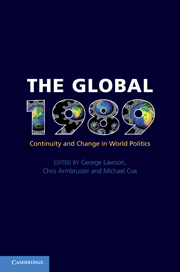Book contents
- Frontmatter
- Contents
- List of figures
- List of tables
- Notes on contributors
- Acknowledgements
- List of abbreviations
- Introduction: the ‘what’, ‘when’ and ‘where’ of the global 1989
- Part I What and when
- Part II Where
- 4 Transatlantic relations in the shadow of the Cold War
- 5 Third World socialism: 1989 and after
- 6 Towards a global Europe?
- 7 Restoration and convergence: Russia and China since 1989
- 8 One world, many cold wars: 1989 in the Middle East
- Part III Continuity and change
- Conclusion: was there a global 1989?
- Bibliography
- Index
6 - Towards a global Europe?
Published online by Cambridge University Press: 05 June 2012
- Frontmatter
- Contents
- List of figures
- List of tables
- Notes on contributors
- Acknowledgements
- List of abbreviations
- Introduction: the ‘what’, ‘when’ and ‘where’ of the global 1989
- Part I What and when
- Part II Where
- 4 Transatlantic relations in the shadow of the Cold War
- 5 Third World socialism: 1989 and after
- 6 Towards a global Europe?
- 7 Restoration and convergence: Russia and China since 1989
- 8 One world, many cold wars: 1989 in the Middle East
- Part III Continuity and change
- Conclusion: was there a global 1989?
- Bibliography
- Index
Summary
1989 and the European integration process
While 1989 is widely acknowledged as a watershed in international relations, it is also regarded as the most major upheaval in the course of European integration since its onset in the 1950s. A glimpse at the chronology of the European integration process makes it obvious that 1989 paved the way for the building of a political union as well as for enlargement to new members. Only three years after the collapse of the communist system, the European Community transformed into a European Union with new and extended competences, including a Common Foreign and Security Policy. In the early 1990s, the European Commission designed a method to enlarge the Union further, opening a wide-ranging process which culminated in the accession of ten new member states in 2004 and two additional members in 2007. The consequences of 1989 for the European integration process were, therefore, far-reaching.
At the same time, 1989 did not happen in a vacuum for the European Community (EC). In the span of thirty years, it had successfully established peaceful relations among its member states. And it had equally successfully sustained cooperation projects which had boosted growth in Western Europe. Even though the European Community had no relations with the Eastern bloc, by the mid-1980s it had gained a sense of attractiveness by way of its integration projects which, arguably, influenced the events which took place in Central and Eastern Europe during the final acts of the Cold War.
- Type
- Chapter
- Information
- The Global 1989Continuity and Change in World Politics, pp. 135 - 156Publisher: Cambridge University PressPrint publication year: 2010
- 1
- Cited by



